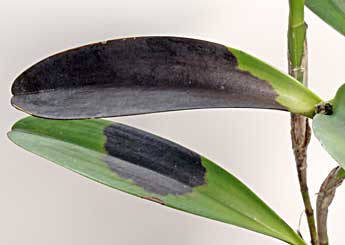This blog we will continue talking about orchid ailment called Black Rot. When the weather is rainy or damp for extended periods, A danger to orchids called black rot can quickly make damage badly to an entire plant if left unchecked. Black Rot is caused by one or both of the fungi Pythium ultimum and Phytophthora cactorum. Black rot affects a wide variety of orchids. Cattleyas seem to be susceptible more than others.

Life Cycle
The fungi that cause black rot in orchids can live only in the damp environments which water is available to them. They consist of independent movement capable spores , called zoospores, which swim through the water. If that water occurs to be sitting on an orchid leaf, the zoospores can go through the plant tissue and start the next stage in their life cycle. At this moment, the fungus develops a vegetative part called mycelium consisting of hyphae (thin, thread-like tubes), which spreads fastly through the affected plant tissues. Once this occurs, the visible indications of infection – small, watery, translucent spots – expand quickly and become changing to brown and then black. if left untreated, the affected plant or plants may infect others and will probably die themselves.
Symptoms
When the fungus attacks young plants, it is usually at the soil line. This can cause the little plants to fall over and die, and is referred to as damping off.
In fully grown plants, the disease can strike at any point on the plant (leaves, pseudobulbs or roots), but often starts in new leaves or growing leads, and progresses downward through the plant until getting to the roots.
As it’s name implies, black rot is easy to notice as dark blackish spots or lesions on the affected plant part. The black spot or spots enlarge quickly and can spread throughout the plant. If allowed to get to the crown of a monopodial (single-stemmed) orchid, the rot will make the plant die. Affected leaves may turn yellow around the infected area, and the lesions themselves will be soft and flow water out slowly and steadily when applying pressure.
Prevention
Unsterilized pots, media or water sources, as well as water splashed from affected plants nearby, are all excellent ways of spreading the fungus. In addition, plants that spend time outdoors should be lifted 3 to 4 feet (90 to 120 cm) above the ground to avoid splash contamination. Do not allow your orchids’ leaves to get wet for any extended periods. Helping plants dry very soon after watering or rains is done by having good air circulation in the growing area. in order to improve the airflow and help prevent the rots from forming, we can add fans to help wick away the extra moisture. the initial signs of infection, we need to separate all those affected plants from the others as to avoid contamination. Finally, some growers advise the use of a high-calcium fertilizer in the spring to help avoid black rot in new growth.

Mechanical Treatment
Stopping the spread of black rot in your orchid, beginning with a sterile knife and cutting out the diseased portion of the plant. Remove all infected plant material, destroy a small amount of healthy tissue next to the infected area as a safety precaution. Examine the cut portion carefully. It is sometimes possible, especially in pseudobulbs, to see a brownish discoloration extending into the inner part of tissue that appears healthy on the surface. In sympodial (many-stemmed) plants such as a cattleya, it may be necessary to cut below the leaves and into the pseudobulb to stop the spreading of the disease. If the plant is badly infected, cut into the rhizome, growth by growth, till you get to the healthy tissue. For a monopodial orchid such as a vanda or phalaenopsis, remove the infected portion of the leaf, or the entire leaf if necessary, to stop the spread of the fungus before it gets to the crown. Place the plant in an area that receives good air circulation to allow the cut to dry.
Chemical Treatment
Once the infected plant parts have been gotten rid of, a fungicide should be applied to protect the remaining healthy tissue. Cinnamon is an excellent fungicide, and ground cinnamon may be applied straight from the spice jar directly to the exposed area where infected portions of the plant have been cut. We also recommends the mixing of cinnamon and either casein-based glue like Elmer’s or cooking oil to get this rather thick paste. This paste is fairly waterproof and can be used to layer the wound.
Another paste which was developed specifically for use on orchids is StopRot. This product contains a Bordeaux mixture in lanolin. The Bordeaux, a mixture of copper sulfate and lime, has fungicidal qualities. The lanolin layers the wound to keep moisture out.
Choosing whatever method, be sure to protect all of the exposed (cut) area with the fungicide or sealant, so that no new infection can be introduced to the open wound.
Drenching the affected plant with fungicide is also another option. Drenches of a protectant fungicide such as Truban or Terrazole are advised if the disease diagnosis is done early. For more complex cases, a systemic fungicide such as Aliette or Subdue is more effectively. Captan, Dithane M-45 and Physan 20 have also been advised by some growers for control of black rot.
Protecting seedlings against damping off, watering with the fungicide of choice (at the dilution rate for seedlings specified in the product’s instructions) immediately they are deflasked and potted in compots. Afterward, treating with a preventive fungicide at two-week intervals.
